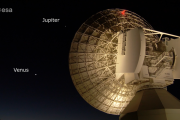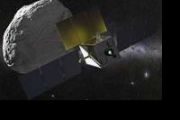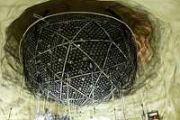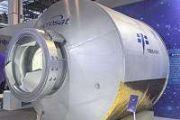
Copernical Team
Space-made aluminium weld analyzed at ESA lab
 ESA engineers have closely examined an aluminium weld produced in space, marking a historic achievement as the first autonomous welding conducted in orbit, and the first of its kind involving ESA. The weld, just one centimeter in size, was produced using electron beam welding during an experiment initiated by ThinkOrbital, a US startup.
This weld, created aboard a spacecraft launched via a
ESA engineers have closely examined an aluminium weld produced in space, marking a historic achievement as the first autonomous welding conducted in orbit, and the first of its kind involving ESA. The weld, just one centimeter in size, was produced using electron beam welding during an experiment initiated by ThinkOrbital, a US startup.
This weld, created aboard a spacecraft launched via a In a first, SpaceX 'catches' megarocket booster after test flight
 SpaceX successfully "caught" the first-stage booster of its Starship megarocket Sunday as it returned to the launch pad after a test flight, a world first in the company's quest for rapid reusability.
The "super heavy booster" had blasted off attached to the Starship rocket minutes earlier, then made a picture-perfect controlled return to the same pad in Texas, where a pair of huge mechanica
SpaceX successfully "caught" the first-stage booster of its Starship megarocket Sunday as it returned to the launch pad after a test flight, a world first in the company's quest for rapid reusability.
The "super heavy booster" had blasted off attached to the Starship rocket minutes earlier, then made a picture-perfect controlled return to the same pad in Texas, where a pair of huge mechanica Starship targets milestone 5th test flight with first booster recovery attempt planned
 SpaceX is gearing up for the fifth test flight of its Starship rocket, with a 30-minute launch window scheduled to open at 7 a.m. Central Time (8am ET) on Sunday, October 13. This important flight will aim to advance SpaceX's efforts toward full reusability for both the Starship vehicle and its Super Heavy booster.
A live webcast of the test will begin approximately 35 minutes before lifto
SpaceX is gearing up for the fifth test flight of its Starship rocket, with a 30-minute launch window scheduled to open at 7 a.m. Central Time (8am ET) on Sunday, October 13. This important flight will aim to advance SpaceX's efforts toward full reusability for both the Starship vehicle and its Super Heavy booster.
A live webcast of the test will begin approximately 35 minutes before lifto China successfully retrieves first reusable test satellite Shijian-19
 China has successfully retrieved its first reusable and returnable test satellite, Shijian-19, marking a significant achievement in the country's space program. According to the China National Space Administration (CNSA), the satellite was recovered at the Dongfeng landing site in Inner Mongolia at 10:39 a.m. Beijing Time on Friday.
"All the returnable payloads in fields like plant and mic
China has successfully retrieved its first reusable and returnable test satellite, Shijian-19, marking a significant achievement in the country's space program. According to the China National Space Administration (CNSA), the satellite was recovered at the Dongfeng landing site in Inner Mongolia at 10:39 a.m. Beijing Time on Friday.
"All the returnable payloads in fields like plant and mic GMV GSharp leads globally in precise GNSS corrections
 GMV, a leader in global navigation satellite systems (GNSS) services, has solidified its position at the forefront of real-time GNSS corrections for precise orbits and clocks through its solution, GMV GSharp. As a key player in the International GNSS Service (IGS), GMV contributes to this global initiative aimed at supporting positioning, navigation, timing (PNT) applications, and geodetic refer
GMV, a leader in global navigation satellite systems (GNSS) services, has solidified its position at the forefront of real-time GNSS corrections for precise orbits and clocks through its solution, GMV GSharp. As a key player in the International GNSS Service (IGS), GMV contributes to this global initiative aimed at supporting positioning, navigation, timing (PNT) applications, and geodetic refer Vector Space Biosciences and Advacam team up for AI-powered cubesat payloads
 Advacam, a provider of advanced radiation detectors for mapping radiation aboard the International Space Station (ISS), and Vector Space Biosciences (crypto symbol: SBIO), a company specializing in AI models for space industry data, have entered into a Letter of Intent (LOI) to collaborate on developing satellite payloads and CubeSats. The partnership aims to support radiation measurement and la
Advacam, a provider of advanced radiation detectors for mapping radiation aboard the International Space Station (ISS), and Vector Space Biosciences (crypto symbol: SBIO), a company specializing in AI models for space industry data, have entered into a Letter of Intent (LOI) to collaborate on developing satellite payloads and CubeSats. The partnership aims to support radiation measurement and la Space Business Insights Explored in New Book
 A new book titled 'Space Business: Emerging Theory and Practice', edited by Professor Arto Ojala from the University of Vaasa, Finland, and Professor William W. Baber from the University of Kyoto, provides an in-depth analysis of the rapidly evolving space industry. The book covers business models, key players, ecosystems, and emerging networks, offering a timely resource for understanding the f
A new book titled 'Space Business: Emerging Theory and Practice', edited by Professor Arto Ojala from the University of Vaasa, Finland, and Professor William W. Baber from the University of Kyoto, provides an in-depth analysis of the rapidly evolving space industry. The book covers business models, key players, ecosystems, and emerging networks, offering a timely resource for understanding the f Researchers find clues to the mysterious heating of the sun's atmosphere
 There is a profound mystery in our sun. While the sun's surface temperature measures around 10,000 degrees Fahrenheit, its outer atmosphere, known as the solar corona, measures more like 2 million degrees Fahrenheit, about 200 times hotter. This increase in temperature away from the sun is perplexing and has been an unsolved mystery since 1939, when the high temperature of the corona was first i
There is a profound mystery in our sun. While the sun's surface temperature measures around 10,000 degrees Fahrenheit, its outer atmosphere, known as the solar corona, measures more like 2 million degrees Fahrenheit, about 200 times hotter. This increase in temperature away from the sun is perplexing and has been an unsolved mystery since 1939, when the high temperature of the corona was first i A new machine learning model sharpens view of the Milky Way using Gaia data
 A team of scientists from the Leibniz Institute for Astrophysics Potsdam (AIP) and the Institute of Cosmos Sciences of the University of Barcelona (ICCUB) have applied advanced machine learning techniques to process data for 217 million stars observed by the Gaia mission. This novel approach efficiently analyzes data to map properties like interstellar extinction and metallicity across the Milky
A team of scientists from the Leibniz Institute for Astrophysics Potsdam (AIP) and the Institute of Cosmos Sciences of the University of Barcelona (ICCUB) have applied advanced machine learning techniques to process data for 217 million stars observed by the Gaia mission. This novel approach efficiently analyzes data to map properties like interstellar extinction and metallicity across the Milky Inside-out Galaxy Growth Spotted in Early Universe with Webb Telescope
 Astronomers using the NASA/ESA James Webb Space Telescope (JWST) have observed the earliest instance of 'inside-out' galaxy growth, dating back just 700 million years after the Big Bang. This discovery sheds new light on galaxy formation in the early universe.
Though 100 times smaller than the Milky Way, the galaxy observed appears remarkably advanced for its age. It features a dense centr
Astronomers using the NASA/ESA James Webb Space Telescope (JWST) have observed the earliest instance of 'inside-out' galaxy growth, dating back just 700 million years after the Big Bang. This discovery sheds new light on galaxy formation in the early universe.
Though 100 times smaller than the Milky Way, the galaxy observed appears remarkably advanced for its age. It features a dense centr 






























